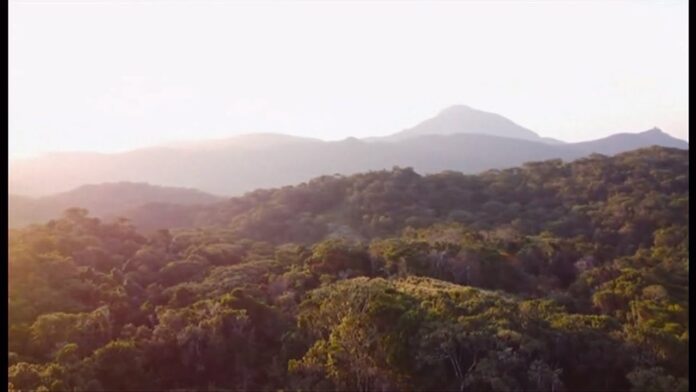Hidden treasures of Mount Mabu
Nestled atop a remote mountain, the Mount Mabu rainforest stands as the largest in southern Africa, a hidden gem now recognized for its rich biodiversity. A recent expedition led by scientists revealed dozens of new species, convincing Mozambique to protect this vital ecosystem. BBC environment correspondent Jonah Fisher joined the team on this remarkable journey.
Dr Gimo Daniel, a passionate beetle expert, joyfully prepares his bait—a rather pungent concoction of his own faeces—while crouched near a small hole in the earth. His excitement mirrors that of the entire team, all eager to uncover what science has yet to document. With his keen sense of discovery, Dr. Daniel believes he has already found 15 new dung beetle species, attracting them from up to 50 meters away.
Mount Mabu remained largely unknown until its discovery by Professor Julian Bayliss in 2004, who identified a dark green patch on satellite images of northern Mozambique. Subsequent expeditions confirmed its significance: a pristine rainforest covering 75 square kilometres, teeming with life. “I was like – oh my God – this is phenomenal,” recalls Prof. Bayliss.
A Unique Ecosystem
Mabu’s geography plays a crucial role in its biodiversity. As a “sky island,” it rises above the surrounding lowlands, creating isolated habitats that foster the evolution of unique species. Since the initial discoveries, scientists have identified at least 25 new species, with many more still pending formal recognition.
This year’s expedition marked the first time researchers set up camp in the forest’s heart, allowing for unprecedented exploration. Mabu’s remote location, coupled with Mozambique’s turbulent history of civil war, has largely shielded it from extensive human intervention, making it a rare oasis in a region where forests face significant degradation.
After a grueling five-hour journey along dirt roads, the team relied on over sixty porters to transport equipment up Mount Mabu’s steep slopes. Among the first discoveries was a new type of small catfish found by Erica Tovela from Mozambique’s Natural History Museum, adding to the growing list of species.
Ongoing Challenges and Conservation Efforts
While Mabu’s forest remains relatively intact, it is not without challenges. The large mammals that once roamed the area, such as lions and rhinos, have been hunted to extinction. Despite the ongoing hunting pressures observed through camera traps, the forest continues to reveal its secrets, including unique smaller mammals like the newly discovered horseshoe bat.
Bird experts Claire Spottiswoode and Callan Cohen focused on locating the Namuli apalis, a rare bird thought to be at risk from climate change. Their efforts paid off when they recorded its call, providing hope for its survival despite the challenges posed by environmental changes.
Encouragingly, Pejul Calenga, director general of Mozambique’s conservation areas, announced plans to establish Mabu as a community-protected area, which will prohibit logging and mining. This management approach empowers local communities while safeguarding the forest’s unique resources.
The Path Forward
With a commitment to global biodiversity pledges, Mozambique aims to protect 30 percent of its land by 2030. The scientists’ discoveries played a pivotal role in advocating for the area’s conservation, underscoring the importance of research in environmental protection.
Prof. Bayliss remains cautiously optimistic about Mabu’s future, envisioning it as a conservation success story while seeking new sites across Africa in need of protection. The journey to safeguard Mount Mabu continues, driven by a shared passion for discovery and preservation.
Analysis
Political
The Mount Mabu discoveries highlight the increasing importance of biodiversity conservation within national and international agendas. The commitment to protect Mabu reflects Mozambique’s alignment with global conservation initiatives, showcasing the role of science in shaping environmental policy.
Social
Public awareness surrounding unique ecosystems like Mount Mabu fosters a collective responsibility toward environmental stewardship. As discoveries emerge, they cultivate a narrative that encourages community engagement and support for conservation efforts, transforming local attitudes toward natural resources.
Racial
The efforts to protect Mount Mabu underscore the need for equitable representation in conservation. Involving local communities in management ensures diverse perspectives and enhances the likelihood of sustainable practices that benefit both the environment and its people.
Gender
The participation of female scientists in the expedition highlights the growing inclusivity in environmental research. Their contributions not only enrich the scientific community but also serve as role models, encouraging more women to pursue careers in STEM and conservation.
Economic
Investing in the conservation of Mount Mabu promises long-term economic benefits. By protecting unique biodiversity, Mozambique can promote eco-tourism and sustainable practices, fostering local economies while preserving invaluable natural resources.
